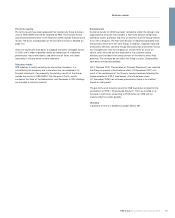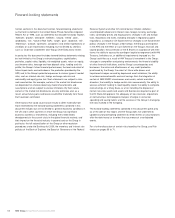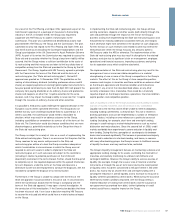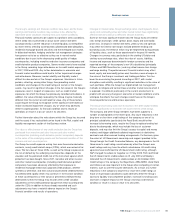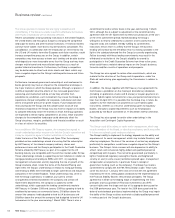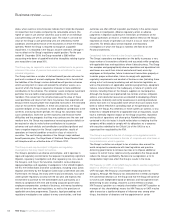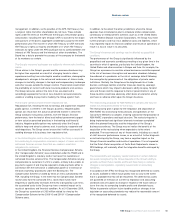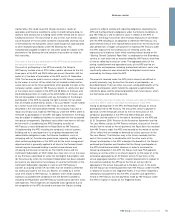RBS 2009 Annual Report Download - page 61
Download and view the complete annual report
Please find page 61 of the 2009 RBS annual report below. You can navigate through the pages in the report by either clicking on the pages listed below, or by using the keyword search tool below to find specific information within the annual report.
59RBS Group Annual Report and Accounts 2009
Business review
The Group’s earnings and financial condition have been, and its future
earnings and financial condition may continue to be, affected by
depressed asset valuations resulting from poor market conditions.
Financial markets continue to be subject to significant stress conditions,
where steep falls in perceived or actual asset values have been
accompanied by a severe reduction in market liquidity, as exemplified
by recent events affecting asset-backed collateralised debt obligations,
residential mortgage-backed securities and the leveraged loan market.
In dislocated markets, hedging and other risk management strategies
have proven not to be as effective as they are in normal market
conditions due in part to the decreasing credit quality of hedge
counterparties, including monoline and other insurance companies and
credit derivative product companies. Severe market events have resulted
in the Group recording large write-downs on its credit market exposures
in 2007, 2008 and 2009. Any further deterioration in economic and
financial market conditions could lead to further impairment charges
and write-downs. Moreover, market volatility and illiquidity make it
difficult to value certain of the Group’s exposures. Valuations in future
periods, reflecting, among other things, then-prevailing market
conditions and changes in the credit ratings of certain of the Group’s
assets, may result in significant changes in the fair values of the Group’s
exposures, even in respect of exposures, such as credit market
exposures, for which the Group has previously recorded write-downs. In
addition, the value ultimately realised by the Group may be materially
different from the current or estimated fair value. Any of these factors
could require the Group to recognise further significant write-downs or
realise increased impairment charges, any of which may adversely
affect its capital position, its financial condition and its results of
operations or result in a loss of value in its securities.
Further information about the write-downs which the Group has incurred
and the assets it has reclassified can be found in the Risk, capital and
liquidity management section of the Business review.
The value or effectiveness of any credit protection that the Group has
purchased from monoline and other insurers and other market
counterparties (including credit derivative product companies) depends
on the value of the underlying assets and the financial condition of the
insurers and such counterparties.
The Group has credit exposure arising from over-the-counter derivative
contracts, mainly credit default swaps (CDSs), which are carried at fair
value. The fair value of these CDSs, as well as the Group’s exposure to
the risk of default by the underlying counterparties, depends on the
valuation and the perceived credit risk of the instrument against which
protection has been bought. Since 2007, monoline and other insurers
and other market counterparties (including credit derivative product
companies) have been adversely affected by their exposure to
residential mortgage linked and corporate credit products, whether
synthetic or otherwise, and their actual and perceived creditworthiness
has deteriorated rapidly, which may continue. If the financial condition
of these counterparties or their actual or perceived creditworthiness
deteriorates further, the Group may record further credit valuation
adjustments on the credit protection bought from these counterparties
under the CDSs in addition to those already recorded and such
adjustments may have a material adverse impact on the Group’s
financial condition and results of operations.
Changes in interest rates, foreign exchange rates, credit spreads, bond,
equity and commodity prices and other market factors have significantly
affected and will continue to affect the Group’s business.
Some of the most significant market risks the Group faces are interest
rate, foreign exchange, credit spread, bond, equity and commodity
price risks. Changes in interest rate levels, yield curves and spreads
may affect the interest rate margin realised between lending and
borrowing costs, the effect of which may be heightened during periods
of liquidity stress, such as those experienced in the past 18 months.
Changes in currency rates, particularly in the sterling-US dollar and
sterling-euro exchange rates, affect the value of assets, liabilities,
income and expenses denominated in foreign currencies and the
reported earnings of the company’s non-UK subsidiaries (principally
Citizens and RBS Securities Inc.) and may affect income from foreign
exchange dealing. The performance of financial markets may affect
bond, equity and commodity prices and, therefore, cause changes in
the value of the Group’s investment and trading portfolios. This has
been the case during the period since August 2007, with market
disruptions and volatility resulting in significant reductions in the value of
such portfolios. While the Group has implemented risk management
methods to mitigate and control these and other market risks to which it
is exposed, it is difficult, particularly in the current environment, to
predict with accuracy changes in economic or market conditions and to
anticipate the effects that such changes could have on the Group’s
financial performance and business operations.
The Group’s borrowing costs and its access to the debt capital markets
depend significantly on its and the UK Government’s credit ratings.
The company and other Group members have been subject to a
number of downgrades in the recent past. Any future reductions in the
long-term or short-term credit ratings of the company or one of its
principal subsidiaries (particularly the Royal Bank) would further
increase its borrowing costs, require the Group to replace funding lost
due to the downgrade, which may include the loss of customer
deposits, and may also limit the Group’s access to capital and money
markets and trigger additional collateral requirements in derivatives
contracts and other secured funding arrangements. Furthermore, given
the extent of UK Government ownership and support provided to the
Group through the Credit Guarantee Scheme, any downgrade in the UK
Government’s credit ratings could adversely affect the Group’s own
credit ratings and may have the effects noted above. All credit rating
agencies have reaffirmed the UK Government’s AAA rating, although
S&P changed its outlook to ‘negative’ on 21 May 2009. Fitch reaffirmed
the UK Government’s stable outlook on 31 July 2009 and Moody’s
reiterated the UK Government’s stable outlook on 26 October 2009.
Credit ratings of the company, the Royal Bank, ABN AMRO, Ulster Bank
and Citizens are also important to the Group when competing in certain
markets, such as over-the-counter derivatives. As a result, any further
reductions in the company’s long-term or short-term credit ratings or
those of its principal subsidiaries could adversely affect the Group’s
access to liquidity and competitive position, increase its funding costs
and have a negative impact on the Group’s earnings and financial
condition or result in a loss of value in its securities.




